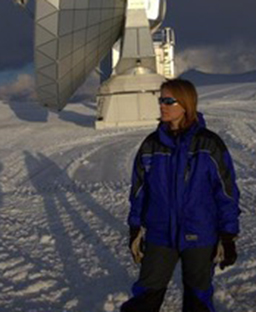 AstroFIt 2 – COFUND fellow since September 1, 2016.
AstroFIt 2 – COFUND fellow since September 1, 2016.
Project ended on October 14, 2018.
INAF Research Centre: Osservatorio Astronomico di Trieste
Email: chiara.feruglio at inaf.it
Curriculum vitae
Talks:
Papers/Publications:
- The WISSH quasars project I. Powerful ionised outflows in hyper-luminous quasars (Astronomy & Astrophysics, 9/12/2016)
- AGN wind scaling relations and the co-evolution of black holes and galaxies (Astronomy & Astrophysics, 16/2/2017)
- X-ray spectroscopy of the z = 6.4 quasar SDSS J1148+5251 (MNRAS, 27/2/2017)
- AGN feedback on molecular gas reservoirs in quasars at z ∼ 2.4 (Astronomy & Astrophysics, 6/7/2017)
- On the discovery of fast molecular gas in the UFO/BAL quasar APM 08279+5255 at z = 3.912 (Astronomy & Astrophysics, 20/9/2017)
- A Molecular gas rich GRB host galaxy at the peak of cosmic star formation (MNRAS, 24/1/2018)
- Molecular outflow and feedback in the obscured quasar XID2028 revealed by ALMA (Astronomy & Astrophysics, 1/2/2018)
- Rest-frame UV-to-optical spectroscopy of APM 08279+5255 BAL classification and black hole mass estimates (Astronomy & Astrophysics, 27/4/2018)
- The WISSH quasars project V. ALMA reveals the assembly of a giant galaxy around a z=4.4 hyper-luminous QSO (Astronomy & Astrophysics, 4/6/2018)
- In and out star formation in z ∼ 1.5 quiescent galaxies from rest-frame UV spectroscopy and the far-infrared (Astronomy & Astrophysics, 2/7/2018)
- ALMA [CI]3P1 −3 P0 observations of NGC 6240: a puzzling molecular outflow, and the role of outflows in the global αCO factor of (U)LIRGs (The Astrophysical Journal, 18/7/2018)
- The Molecular and Ionized Gas Phases of an AGN-driven Outflow in a Typical Massive Galaxy at z ≈ 2 (The Astrophysical Journal, 24/7/2018)
- Witnessing Galaxy Assembly at the Edge of the Reionization Epoch (ApJ Letters, 6/8/2018)
- The dense molecular gas in the z ∼ 6 QSO SDSS J231038.88+185519.7 resolved by ALMA (Astronomy & Astrophysics, 21/8/2018)
- The WISSH quasars Project: II. Giant star nurseries in hyper-luminous quasars (Astronomy & Astrophysics, 3/9/2018)
- MAGNUM survey: A MUSE-Chandra resolved view on ionized outflows and photoionization in the Seyfert galaxy NGC 1365 (Astronomy & Astrophysics, 6/9/2018)
- ALMA observations of cold molecular gas in AGN hosts at z ∼1.5 – Evidence of AGN feedback? (MNRAS, 10/9/2018)
- Early Science with the Large Millimeter Telescope: An Energy-driven Wind Revealed by Massive Molecular and Fast X-Ray Outflows in the Seyfert Galaxy IRAS 17020+4544 (The Astrophysical Journal Letters, 29/10/2018)
Project title: SWING – The role of superwinds in the life cycle of galaxies
Abstract:
Superwinds are galaxy wide, energetic and mass loaded outflows of gas. Superwinds are common at all redshifts, and they may affect an important fraction of the baryons in the universe. Superwinds may be the long-sought vectors of AGN radiative feedback, and the dominant feedback mechanism for galaxy growth; but how do they work?
Conclusive evidence of superwinds affecting galaxy structure and evolution is still ahead of us, due to the biases and paucity of current studies. A systematic investigation is needed to make progress.
SWING aims at building on firm grounds our understanding of the impact of superwinds in the life cycle of galaxies through cosmic time. SWING is designed to carry out the first statistically sound investigation of superwinds by combining the insights provided by the detailed study of the interplay between superwinds and ISM/CGM in individual sources, with the demographic information obtained on unbiased samples from z=0 to 4.
This empirical approach is implemented into four work-packages (WP):
– Demography and scaling relations between superwinds and galaxy/AGN physical properties, along cosmic time with the smallest systematic errors (WP-STAT)
– Physical (WP-MAP) and chemical (WP-CHEM) effects of superwinds on the ISM
– Impact of superwinds on the galaxy ecosystem at the main epoch of galaxy and AGN assembly (WP-ENV).
These will not only lead to a better understanding of the role of superwinds in the evolution of galaxies, but will also be instrumental to inform the sub-grid treatment of superwinds in detailed cosmological hydrodynamic simulations of galaxy formation, carried out by the group of computational cosmology at OATs, which will provide the theoretical interpretative and predictive framework. The main SWING breakthroughs are the use of unbiased blind samples, and the first systematic application to the extragalactic scenario of astrochemistry techniques previously used on Milky Way studies.
